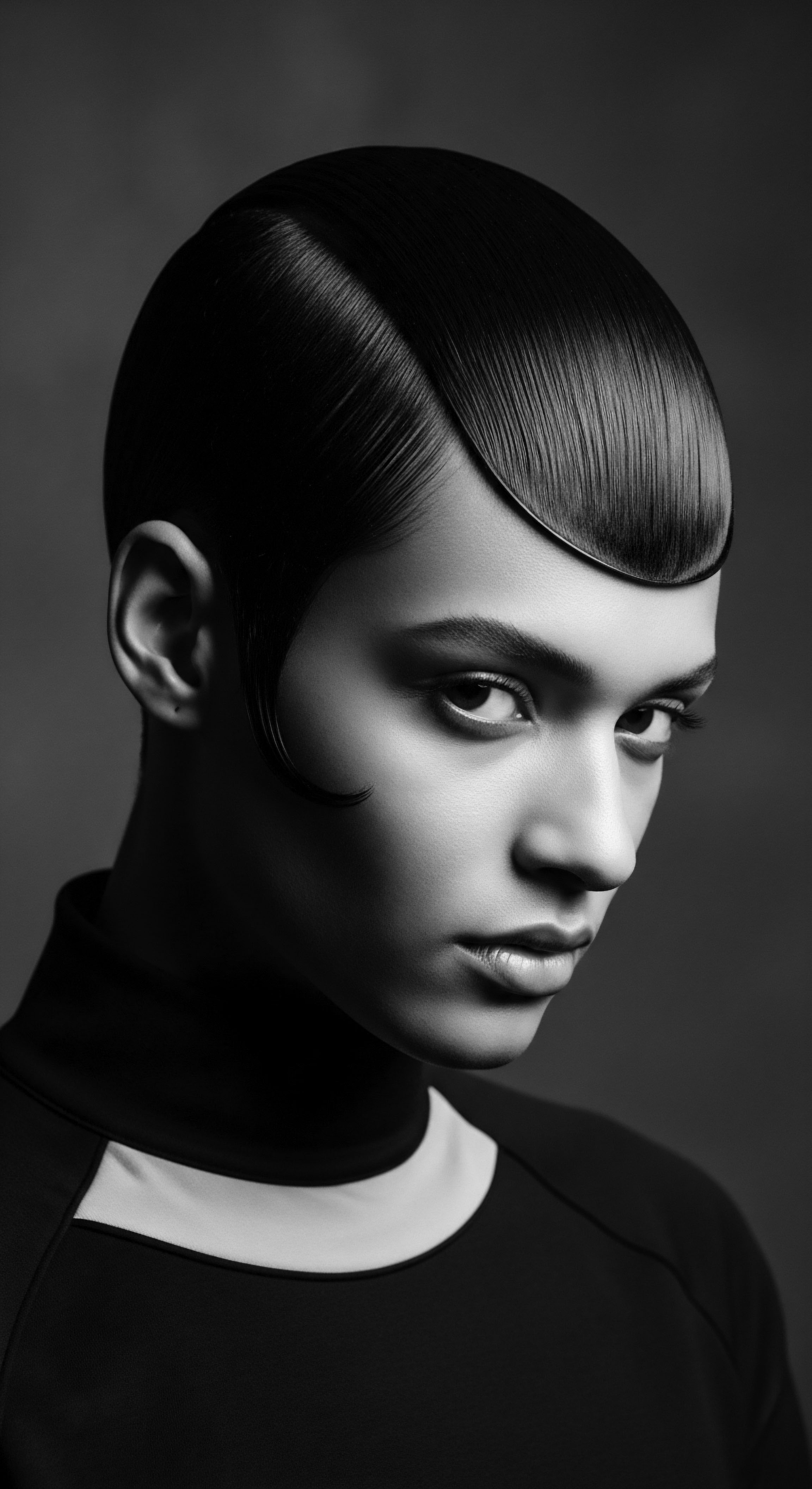
Roots
To stand here, at the crossroads of ancestral whispers and contemporary hum, is to witness a profound lineage. It is to feel the gentle tug of memory from countless hands that have tended textured hair through the ages. We consider here how the deeply rooted practices of cleansing, born from the very earth and wisdom of our forebears, still shape the rituals we observe today.
How does the elemental act of purifying our strands echo across generations, influencing the way we approach textured hair care in this moment? This exploration is a conversation with history, a soulful inquiry into the enduring heritage of cleansing.

Hair’s Unique Blueprint ❉ Ancestral Understanding
Textured hair, in its myriad forms, possesses a distinct anatomical blueprint. Its elliptical cross-section, the tight helical coil, and the often drier nature of its cuticle demanded a unique approach to care, one instinctively recognized by those who lived intimately with the land and its offerings. Unlike straight hair, which allows sebum to travel down the shaft with ease, the coils of textured hair mean natural oils have a more circuitous route. Ancestral communities understood this inherent dryness, leading to cleansing methods that honored the hair’s need for moisture, rather than stripping it away.
They observed, they learned, they innovated from the bounty around them. This deep, empirical understanding of textured hair’s physiology laid the groundwork for practices that prioritized preservation and nourishment, a heritage of care that stretches back into distant time.

Cleansing from the Earth’s Embrace
Before bottled formulations, cleansing agents arose directly from the earth. Clays, rich in minerals, and plants with saponin properties served as the original purifiers.
Ancestral cleansing practices for textured hair were not simply about hygiene; they were a dialogue with the natural world, a testament to deep knowledge of botanical and mineral properties.
The Himba people of Namibia, for instance, utilize a mixture of butterfat and ochre pigment, known as Otjize, not only for protection from the sun and insects but also for hygienic purposes. As otjize flakes off, it removes dirt and dead skin, serving as a cleansing mechanism where water is scarce. This speaks to a profound adaptation to environment, where cleansing was integrated with protection and adornment.
Another powerful example from West Africa is African Black Soap (also called Ose Dudu or Alata Simena). This traditional cleanser, originating with the Yoruba people of Nigeria and still made in Ghana today, combines ash from plantain skins, cocoa pods, and palm leaves with various oils like coconut and shea butter. Its creation is often a communal process, passed down through generations, embodying collective wisdom and a sense of shared heritage. The gentle, yet effective, cleansing properties of these natural ingredients meant that ancestral hair was purified without being unduly stripped, setting a precedent for the moisture-retaining regimens of today.
- Clays ❉ Rhassoul and Bentonite, for example, were used for thousands of years in North African and Arab cultures for their purifying properties on skin and scalp. Their mineral content aids in gentle cleansing and drawing impurities.
- Saponin-Rich Plants ❉ Plants like Soapnut (reetha), Shikakai (Acacia concinna), and Yucca Root contain natural compounds that create a mild lather, offering effective cleansing without harsh detergents. These were used across diverse regions, from India to Native American communities.
- Fermented Rinses ❉ While not direct cleansers, practices like using fermented rice water in Asian traditions illustrate an ancient understanding of beneficial microbial activity and nutrient absorption for hair health, sometimes acting as a post-cleansing rinse.
These methods, born from observation and deep respect for nature’s provisions, reveal that our ancestors were discerning scientists in their own right. They understood the relationship between the cleansing agent, the hair’s unique structure, and the overall well-being of the scalp. This ancestral knowledge is a beacon, guiding us to appreciate the scientific wisdom embedded in practices that long precede modern chemistry.

Ritual
The act of cleansing textured hair, particularly within Black and mixed-race communities, has always transcended mere hygiene. It has held the weight of cultural custom, communal bonding, and deep spiritual significance. The way hair was cleansed was intimately bound to the rituals of life, marking rites of passage, social status, and personal identity. This is where the heritage of cleansing truly takes on a living, breathing form, connecting each strand to a vast lineage of tender care.

What Practices Shaped Historical Hair Cleansing Routines?
Historical cleansing routines were often methodical, unhurried, and communal. They were opportunities for mothers, daughters, and community elders to gather, to share stories, to impart wisdom, and to strengthen bonds. This human element is a vital component of the heritage we discuss. The preparation of cleansing agents, whether grinding herbs or preparing clays, was part of the ritual, infusing the process with intention and collective energy.
Cleansing was frequently followed by extensive oiling and styling, suggesting an understanding that moisture replenishment was paramount after the removal of impurities. Early hair care in pre-colonial Africa involved washing, combing, oiling, braiding or twisting, and decorating the hair, often taking hours or days and serving as social opportunities.
Consider the pre-shampoo era, where daily washing was not the norm, and gentler, less frequent cleansing was the practice. This stands in stark contrast to the aggressive daily lathering promoted by early commercial shampoos. Ancestral methods, with their reliance on mild, naturally occurring surfactants or absorbent clays, inherently promoted what we now refer to as “low-poo” or “no-poo” methods. The intent was not to strip the hair, but to refresh and purify with minimal disruption to its natural moisture balance.
The concept of Co-Washing, a popular contemporary practice where hair is cleansed primarily with conditioner, has deeper roots than its modern coinage suggests. While the term gained popularity in the 1990s and 2000s within the curly and natural hair communities seeking alternatives to harsh sulfate shampoos, the underlying principle of gentle, moisture-preserving cleansing without excessive suds aligns with ancestral approaches. Imagine ancestors simply rinsing their hair with water, then working in a rich oil or butter, perhaps infused with herbs, to help loosen debris and nourish the strands simultaneously. This mirrors the dual action of a modern co-wash.
| Ancestral Cleansing Approach Use of saponin-rich plants (e.g. Shikakai, Reetha) for mild lather. |
| Contemporary Parallel or Influence Low-lather or sulfate-free shampoos, prioritizing gentle cleansing. |
| Ancestral Cleansing Approach Clay-based washes (e.g. Rhassoul) for impurity absorption. |
| Contemporary Parallel or Influence Bentonite or Rhassoul clay masks in modern hair routines for detoxification. |
| Ancestral Cleansing Approach Water-only or water-plus-oil rinses for refresh and moisture. |
| Contemporary Parallel or Influence Co-washing (conditioner-only washing) and "no-poo" methods. |
| Ancestral Cleansing Approach African Black Soap for gentle but effective purification. |
| Contemporary Parallel or Influence Natural, traditionally made cleansing bars and liquid soaps. |
| Ancestral Cleansing Approach The enduring wisdom of ancestral cleansing practices continues to resonate, shaping our understanding of hair's true requirements. |
The tools of cleansing also carried a heritage significance. While modern tools like plastic combs and brushes are ubiquitous, ancestral tools were crafted from natural materials, reflecting the resources available and a sustainable approach to life.
- Wooden or Bone Combs ❉ Used for detangling during or after washes, these tools were often handmade, respecting the delicate nature of textured strands. Their wider teeth prevented excessive breakage.
- Natural Sponges ❉ Plant-based sponges or cloths were likely used for gentle application and removal of cleansing agents, minimizing friction on the hair cuticle.
- Gourds and Clay Vessels ❉ These served as containers for mixing and holding washes and rinses, connecting the act of cleansing directly to the earth’s vessels.
The communal dimension of these cleansing rituals was not merely practical; it was foundational to social cohesion and the preservation of knowledge. Lore surrounding hair care, including specific cleansing recipes and techniques, traveled through oral traditions, passed down from one generation to the next. This living transmission of knowledge ensures that even as methods evolve, the spirit of ancestral care persists, a vibrant current in the vast river of textured hair heritage.

Relay
The journey of ancestral cleansing methods from ancient wisdom to contemporary influence is not a relic of the past; it is a living relay, a continuous exchange where ancient insight informs and validates modern understanding. This section explores how scientific inquiry often finds itself mirroring, or explaining, the deeply intuitive practices of our forebears, especially when considering the intricate biology of textured hair and the nuanced science of its care.

How Do Ancient Cleansing Methods Find Validation in Modern Science?
Modern trichology and dermatology increasingly recognize the wisdom embedded in ancestral cleansing. For instance, the emphasis on maintaining the scalp’s delicate ecosystem, known as the Scalp Microbiome, aligns directly with the gentle nature of traditional cleansers. Harsh modern shampoos, often laden with sulfates, can strip the scalp of its natural protective oils and disrupt this bacterial and fungal balance, leading to irritation, dryness, and even hair loss.
Ancestral cleansers, with their milder, often pH-balancing properties, supported a healthier scalp environment. Clays, for example, could absorb excess oil without completely desiccating the scalp, while plant-based saponins offered a gentle, non-stripping cleanse.
The subtle efficacy of ancestral cleansing agents reveals a sophisticated, intuitive grasp of hair and scalp biology that modern science is now validating.
Research on natural ingredients commonly used in ancestral cleansing provides compelling evidence of their efficacy. For example, studies on African Black Soap have shown its composition, including plant ashes and various oils, provides cleansing properties without stripping natural oils, supporting both hair and scalp health. Similarly, the saponins found in plants like reetha and shikakai are natural surfactants that cleanse effectively while leaving hair soft and manageable. This aligns with the contemporary quest for “clean beauty” and sulfate-free formulations, demonstrating a return to principles deeply rooted in heritage.
The historical practice of “pre-shampooing” or applying oils and butters before a wash also finds its scientific basis in modern understanding. Ancestral butters, like those from Amazonian fruits such as Cupuaçu, Murumuru, and Açaí, were used as pre-washes to nourish and protect hair before cleansing, improving regeneration and repair. This technique of coating the hair with an oil prior to washing minimizes the stripping effect of water and cleansing agents, preserving the hair’s natural lipids and protecting the delicate protein structure of the hair shaft. This method reduces hygral fatigue, the swelling and shrinking of hair as it gets wet and dries, which can lead to damage over time, especially in highly porous textured hair.

Sustaining Heritage ❉ Cleansing and Ethical Practices
The environmental footprint of ancestral cleansing methods stands in stark contrast to the complexities of modern industrial production. Ingredients were locally sourced, often wild-harvested or cultivated with traditional methods, minimizing transportation and processing. The products were inherently biodegradable, returning to the earth without leaving behind chemical residues. This deep connection to the land and a sustainable approach to resource use form a vital aspect of the heritage of cleansing.
This approach to sourcing and production holds profound lessons for contemporary ethical hair care. Consumers today are increasingly seeking products that are not only effective but also environmentally responsible and ethically produced. The ancestral model offers a blueprint for this:
- Local Sourcing ❉ Prioritizing ingredients from local ecosystems, reducing carbon footprints and supporting regional economies.
- Minimal Processing ❉ Favoring raw or minimally altered natural ingredients, preserving their inherent beneficial properties.
- Biodegradeability ❉ Opting for formulations that break down harmlessly into the environment.
The concept of “Cosmetopoeia,” the traditional knowledge system of cosmetic plants, offers a rich field for further study, highlighting the vast, yet often under-researched, body of African plant knowledge for hair care. While ethnobotanical studies focusing specifically on nutricosmetic plants for hair care in Africa are scarce, research is ongoing to validate these traditional therapies and understand their mechanisms, often moving beyond a single-target approach to appreciate their systemic, nutritional effects. For example, specific plants used traditionally for general hair care in West Africa, such as Cannabis sativa L. or Ipomoea aquatica Forssk., have historical records of leaf or seed extracts applied to the scalp for hair conditioning and even baldness treatments. This ongoing scientific validation bridges the gap between ancestral observation and contemporary empirical data, confirming the profound legacy of wisdom.
The cultural resilience of textured hair, often expressed through its various styles and meticulous care, is deeply intertwined with these cleansing traditions. Even amidst periods of immense cultural disruption, such as the transatlantic slave trade, where ancestral hair practices were suppressed, the memory of these methods, and the inherent understanding of textured hair’s needs, persisted. This endurance reflects not only the physical properties of the hair but also the profound spiritual and cultural significance it held, making cleansing a silent act of preserving identity. The act of cleansing itself became a form of resistance, a way to hold onto a piece of self and heritage in the face of forced assimilation.

Reflection
To journey through the history of cleansing methods for textured hair is to walk a path illuminated by ancestral wisdom. It is to recognize that the care practices we employ today are not isolated innovations, but rather echoes from a deep past, whispers carried on the wind of generations. The very act of cleansing our strands becomes a profound meditation, a moment where the ancient and the present merge, honoring the legacy ingrained in every coil and curl.
The Soul of a Strand, truly, lives within this continuum. It is a living archive, where the intuitive knowledge of our forebears regarding plant properties, the communal rhythms of their care rituals, and their deep understanding of hair’s unique biology continue to instruct us. From the protective clays of the Atlas Mountains to the saponin-rich plants of West Africa, from the shared moments of grooming to the silent acts of resilience in times of oppression, the heritage of cleansing textured hair is an enduring testament to ingenuity, adaptation, and unwavering self-reverence. In each mindful wash, we do more than purify; we participate in a timeless dialogue, reinforcing the strength, beauty, and profound cultural memory held within our textured hair.

References
- Byrd, Ayana D. and Tharps, Lori L. Hair Story ❉ Untangling the Roots of Black Hair in America. St. Martin’s Press, 2001.
- Dabiri, Emma. Twisted ❉ The Tangled History of Black Hair Culture. Harper Perennial, 2020.
- Kalu, Anthonia. The Dynamics of Culture and Human Development in Africa. Goldline & Prestige, 1999.
- Omotoso, Sharon Adetutu. “Gendered and Politicised Perspectives of African Hair in Africa.” Journal of Pan African Studies, vol. 4, no. 5, 2011, pp. 1-15.
- Saurabh Dilip Bhandare, Sarika Shivaji Malode, Niphade Srushti Sunil, Pagar Pranali Anil, and Vijay Dhondiram Wagh. “Preparation and evaluation of herbal hair growth and hair cleansing shampoo.” World Journal of Pharmaceutical Research, vol. 11, no. 16, 2022, pp. 696-709.
- White, Luise. Speaking with Vampires ❉ Rumor and History in Colonial Africa. University of California Press, 2000.
